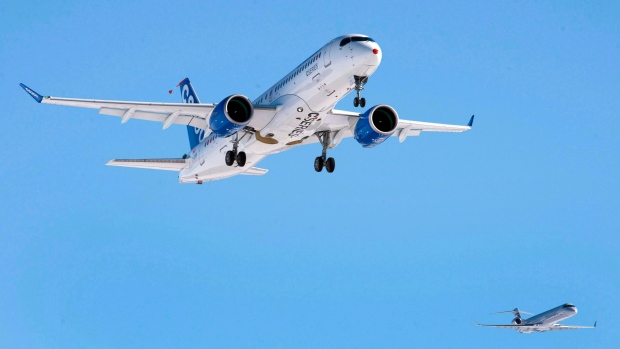Jun 17, 2019
Aerospace industry at risk of further decline: Charest report
The Canadian Press

MONTREAL -- The aerospace industry is "at risk" of being overtaken by foreign rivals if government doesn't treat it as an "urgent priority" and work with the sector to staunch falling employment and GDP contributions, an industry report says.
New funding commitments, Canada-first defence procurement and fresh talent amid "a massive labour crunch" are key to staunching the decline, according to the Aerospace Industries Association of Canada (AIAC) report, authored by former Quebec premier Jean Charest.
"We need a heck of a lot more people in the industry," Charest told The Canadian Press from France ahead of the Paris Air Show.
"We are clearly trying to influence the leaders of the next federal election campaign. We make no bones about that."
The report comes amid growing concerns about the state of aerospace manufacturing and maintenance, as Bombardier looks to exit the commercial aviation business and global aircraft production edges toward a duopoly dominated by Boeing and Airbus.
"Global competition has never been tougher, and we're at a turning point where Canada must step up, or risk being left behind," Charest said.
Since 2012, aerospace employment and GDP contributions in Canada have declined five per cent and four per cent, respectively, according to the Department of Innovation, Science and Economic Development.
The industry furnished 213,200 jobs last year and injected $25.5 billion into the economy, but will need 50,000 more workers within the next few years, the report states, stressing the need for talent.
It calls for a national system to co-ordinate co-op placements, fast-track immigration for skilled aerospace workers and partner with stakeholders to create national training centres.
The report also recommends launching a "national defence industrial strategy" and overhauling the procurement process to open it up to small business and industry giants alike.
"We bounced around the idea of 'Buy Canada,"' Charest said. But about 40 per cent of both aerospace exports and research and development in Canada is done by foreign companies like Pratt & Whitney and Bell Helicopter, he said. Instead the report proposes a "Buy for Canada" approach that encourages more "strategic" procurement.
"Let's make sure we get the IP when we buy equipment, make sure that we do the in-service work that is profitable over the long term when we buy procurement," Charest said.
Aerospace facilities already span the country -- Western and Atlantic Canada host more than 50 per cent of maintenance and repair activity -- even as the Bombardier linchpin has loosened.
"Bombardier is no longer the bellwether company it once was in aircraft manufacturing in this country," said Robert Kokonis, president of Toronto-based consulting firm AirTrav Inc. But that doesn't spell disaster for Canadians, he said.
Canada boasts about 500 small and medium-sized aerospace firms, according to the AIAC. Prominent companies such as CAE Inc., Heroux-Devtek, B.C.-based Longview Aviation Capital -- which recently scooped up Bombardier's Q400 program and whose Viking Air Ltd. subsidiary pumps out water bombers and turboprops -- and Ontario-based Magellan Aerospace Corp. all speak to the aerospace presence on Canadian turf.
Meanwhile Bombardier continues to ramp up production of the Global 7500, "a world-leading aircraft" that entered into service in December and is on track for between 15 and 20 deliveries this year and between 35 and 40 in 2020.
"Bombardier has essentially chosen to exit the commercial business, but the market evolves," said AltaCorp Capital analyst Chris Murray.
"Aerospace does not operate in a vacuum. It truly is a global industry and that's something that has to be reflected in whatever decisions the government makes."
The AIAC report pegs air transportation as a $10-trillion market. Traditional aerospace competitors such as the United States, France and the United Kingdom retain hefty slices of the pie, but hungry new entrants such as India, Vietnam and Singapore are also at the table.
"They're thinking long-term -- as far as 50 years out - and they're moving fast," Charest said in the paper.
He invoked Canada's history of aerospace manufacturing, which took off during the Second World War and continued with the supersonic Avro Arrow jet and the Canadarm for NASA's space shuttle program.
"That did not happen by accident. It happened because government and industry shared a vision, worked and invested together," Charest said.
He contrasted Canada's competitive position with that of China -- which in January completed the first-ever unmanned landing on the far side of the moon -- and Japan, which has forged ahead with a national space program.
The report recommends collaborating with stakeholders to continue a national strategy for space, which Ottawa rolled out in March and which includes Lunar Gateway -- a NASA-backed project for an orbiting space platform -- low-earth orbit broadband satellites and commercial space sector investment.
Other recommendations include investing in collaborative efforts between government and industry to foster carbon-neutral flight efforts and unmanned vehicles.
On Sunday, Innovation Minister Navdeep Bains announced an investment of up to $49 million to establish a "national aerospace innovation ecosystem" that aims to tackle technological challenges, bring products to market and create highly skilled jobs.





